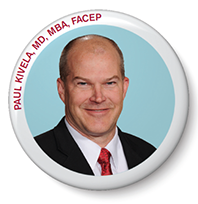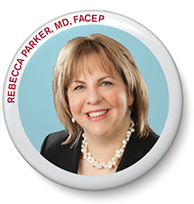
Each October at ACEP’s annual Council meeting, the ACEP Council elects new leaders for the College. The Council, which represents all 53 chapters, 33 sections of membership, the Association of Academic Chairs in Emergency Medicine, the Council of Emergency Medicine Residency Directors, the Emergency Medicine Residents’ Association, and the Society for Academic Emergency Medicine, will elect the College’s President-Elect, four members to the ACEP Board of Directors, the Council Speaker, and the Council Vice Speaker. This month, we’ll meet the President-Elect candidates. In September, we’ll meet the Board of Directors candidates, and in October, we’ll meet the candidates for Council positions.
Explore This Issue
ACEP Now: Vol 34 – No 08 – August 2015President-Elect
The following Board members are candidates for the office of President-Elect. They responded to the following question:
What are the top two issues facing ACEP members today, and how should they be addressed?
Paul Kivela, MD, MBA, FACEP (California)
 Current Professional Positions: attending physician and co–managing partner, Napa Valley Emergency Medical Group; medical director, Medic Ambulance; executive VP, chief medical officer, Newsura Insurance Services (insurance brokerage)
Current Professional Positions: attending physician and co–managing partner, Napa Valley Emergency Medical Group; medical director, Medic Ambulance; executive VP, chief medical officer, Newsura Insurance Services (insurance brokerage)
Internships and Residency: emergency medicine residency, LA County–UCLA Harbor
Medical Degree: MD, University of Illinois (1990)
Candidate Question Response
![]() There are many important issues facing emergency medicine. I believe the top two issues facing ACEP members today are the constant challenge of adapting to the changing practice environment and the struggle to protect fair payment for our services.
There are many important issues facing emergency medicine. I believe the top two issues facing ACEP members today are the constant challenge of adapting to the changing practice environment and the struggle to protect fair payment for our services.
Changes in the health care environment have forced emergency physicians to be more than just great physicians. We have to deal with gaps in resources and also be great managers of personnel, information technology, resource utilization, and coordination of care. Every day our job becomes more difficult. Our scope of practice is continuing to expand. We have to cover gaps in patient care as specialists become increasingly unavailable. We are tasked to maintain satisfaction and department efficiency and at the same time manage more patients even when inpatient beds are functionally or structurally unavailable.
ACEP must advocate to decrease the administrative burdens that do not add value to patient care. We have to work with IT vendors and government regulators so we spend less time in front of a computer and more time connecting with patients. We have to make sure “every click counts” and the efficiency of computerized physician order entry and electronic medical record systems improve. We have to establish standards and distribute the best practices to our members.
We need to educate emergency physicians how to more efficiently manage and supervise not only a constantly changing group of nurses but also nurse practitioners, physician assistants, scribes, and other members of the emergency medicine team.
We need to expand our advocacy for procedural sedation, observation medicine, care coordination, and other skills that meet our patients’ demands.
We have to make sure that we offset quality and cost-containment measures with medical malpractice solutions.
We need to be given control of the resources we need to become the coordinators of patient care and allocators of acute health care resources. We are the most capable physicians to manage and care for patients with complex medical conditions and acute psychiatric problems. We have to make sure these patients are not just left to board in the emergency department.
Whether you are a partner in a democratic group or employed by a large medical group, hospital, or academic center, you deserve to be paid fairly. It is disheartening to hear of the burdensome amount of debt with which many of our recent graduates are leaving residency. Recruiting the best and brightest to our specialty requires us to be diligent in our methodology and to ensure fair payment for our services.
ACEP needs to vigorously advocate to ensure insurance companies pay fairly. We have to engage policymakers, the media, the public, and other decision makers on the value of the care we provide. We must ensure that there is a standard for what constitutes fair payment. We have to work with patient advocacy groups to make sure the high-deductible plans have affordable patient responsibilities and do not shift more health care dollars to insurance companies.
As states pass laws that “rate set” emergency physician payments, we need to take an aggressive legal and possibly even lead a Constitutional challenge to make sure that insurance companies, Medicare, and Medicaid pay their fair share. As Medicaid and Medicare numbers expand and the number of insured commercial patients decreases, we need to make sure that all pay fairly. This responsibility cannot be shifted to a decreasing number of commercially insured patients.
We need to protect graduate medical education funding. We need to assist with the American Board of Emergency Medicine/American Osteopathic Board of Emergency Medicine merger so that residency spots are not lost and advocate for increased funding to train the numbers of emergency physicians needed.
We need to be at the forefront of developing alternative payment modalities that demonstrate our value and create gain-sharing agreements so that emergency physicians are compensated for their conservation of resources and care coordination. We need to create win-win-win situations for payers, physicians, and, most important, patients.
We need to educate and engage patients, economists, regulators, the media, and others to appreciate the care we provide so that they advocate and change the perception that emergency medicine is valuable and not expensive and unnecessary.
Robert E. O’Connor, MD, MPH, FACEP (Virginia)
 Current Professional Positions: professor and chair, physician-in-chief, department of emergency medicine, University of Virginia Health System, Charlottesville; emergency physician, UVA Culpeper Hospital, Culpeper, Virginia
Current Professional Positions: professor and chair, physician-in-chief, department of emergency medicine, University of Virginia Health System, Charlottesville; emergency physician, UVA Culpeper Hospital, Culpeper, Virginia
Internships and Residency: emergency medicine residency, Medical Center of Delaware
Medical Degree: MD, Medical College of Pennsylvania (1982)
Candidate Question Response
![]() Mission Statement: The American College of Emergency Physicians promotes the highest quality of emergency care and is the leading advocate for emergency physicians, their patients, and the public.
Mission Statement: The American College of Emergency Physicians promotes the highest quality of emergency care and is the leading advocate for emergency physicians, their patients, and the public.
I find the ACEP mission statement to be both inspirational and aspirational. I use the statement to guide my professional activities, both personally and on behalf of ACEP, and to identify and execute priorities that advance the field. My professional priorities in emergency medicine, as a physician, have been to provide the highest quality patient care that I am capable of and to work, as a leader, toward achieving a practice environment that facilitates the most efficient and effective patient care. Using these guiding principles, I am convinced that the two top issues facing ACEP members today are access to care and patient safety.
Emergency medicine is recognized by the public as a valued and essential public service, yet access to emergency care is being threatened. Financial barriers are emerging and include high co-payments, high deductibles, restrictive rules regarding out-of-network care, and lack of adequate health care coverage for all patients. Patients do not choose where and when they will need our services and should not face financial penalties for seeking emergency care. Likewise, emergency physicians do not choose which patients they will see on any given day and, furthermore, are required by EMTALA to medically screen all patients. Fair payment is one of the key drivers for access to care by allowing for staffing with board-certified emergency physicians, in adequate numbers, to provide timely high-quality care.
Fair payment is one of the most pressing issues facing emergency physicians in protecting patient access to care. ACEP has the opportunity to use strategies such as the Clinical Emergency Data Registry (CEDR) and other data sources to demonstrate the value of emergency care and justify fair payment. ACEP can also promote how to use these data to quantify how restricted access to care negatively impacts patients, most notably for patients with behavioral health needs and admitted patients who sit for hours in the ED waiting for an inpatient bed, and to suggest possible solutions.
Boarding is a threat to patient safety, not only to the patients who are being held in the ED but also to patients who seek initial evaluation, because needed treatment space is otherwise occupied. Admitted patients who are held in the ED have worse outcomes, have longer lengths of stay in the hospital, and divert resources that should be used to care for others in the ED.
We need to solve ED boarding through advocacy and by partnering with insurers and others in the health care industry to identify the harm and costs associated with delays and to link hospital and behavioral health payments to the reduction and elimination of boarding.
ACEP can play a leading role in elevating the stature of our specialty at the hospital level by advocating for our patients and being given the resources to provide the highest quality care. By achieving our patient safety goals, emergency medicine will be recognized as a major factor impacting outcomes throughout the health care system and promoting the health of the community.
Rebecca Parker, MD, FACEP (Illinois)
 Current Professional Positions: attending physician, Vista Health System, Waukegan, Illinois; senior vice president, Envision Healthcare; president, Team Parker LLC, consulting group for coding, billing, and compliance; clinical assistant professor, Texas Tech University El Paso Department of Emergency Medicine
Current Professional Positions: attending physician, Vista Health System, Waukegan, Illinois; senior vice president, Envision Healthcare; president, Team Parker LLC, consulting group for coding, billing, and compliance; clinical assistant professor, Texas Tech University El Paso Department of Emergency Medicine
Internships and Residency: emergency medicine residency, Texas Tech University Health Sciences Center El Paso
Medical Degree: MD, Northwestern University Medical School (1995)
Candidate Question Response
![]() Our top issue is to implement the Affordable Care Act (ACA). Our specialty must cement its role as the nexus of emergent delivery care and then expand beyond the emergency department to lead the new acute care continuum. ACEP has an unprecedented opportunity to provide strategy for this collaborative effort. The security of our beloved specialty both clinically and financially will give us the opportunity to soar.
Our top issue is to implement the Affordable Care Act (ACA). Our specialty must cement its role as the nexus of emergent delivery care and then expand beyond the emergency department to lead the new acute care continuum. ACEP has an unprecedented opportunity to provide strategy for this collaborative effort. The security of our beloved specialty both clinically and financially will give us the opportunity to soar.
Our clinical world is rapidly changing. We take care of the sickest patients every single day, and we save lives. We know what to do with both critically ill and obviously well patients. The problem lies with the “in-betweeners”: those patients not ill enough to stay but not well enough to discharge or those without access to a clinic or specialties such as psychiatry.
In response to this issue, our colleagues are doing what they do best: piloting creative solutions. With urgent care centers, freestanding EDs, telemedicine, paramedicine, care coordination, and observation units, our emergency physician colleagues are delivering cutting-edge care to our patients.
Since the passage of the ACA in 2010, ACEP members have focused on quantifying and advocating for the value of emergency medicine and the emergency physician. With the Supreme Court decisions that upheld key portions of the ACA, along with recent passage of the SGR repeal (Medicare Access and CHIP Reauthorization Act, or MACRA), the importance of advocating for the value of emergency physicians is now paramount.
With the MACRA-mandated reform, we know our Medicare pay is stable. We also know our pay will be tied to quality measures and alternative payment models (APMs). Now is the time to secure our place within the chorus of voices working together to implement health care reform.
First, we must finish creating our specialty’s first quality registry (Clinical Emergency Data Registry, or CEDR) and follow it with an economic registry. With these registries, we can create clinically relevant quality measures, improve the care we deliver, and quantitatively prove our value while fighting insurer misbehavior. Second, we’ll develop APMs by sharing our members’ innovative approaches. We need to bring together these pilot models to create APMs, such as accountable care organizations, to be the collaborative physician leaders in the new acute care continuum. The only way we can practice the medicine we want is to create the practice we want.
Another top issue is workforce stability, which includes growth and diversity.
Workforce stability starts with job satisfaction. We need scribes to help with burdensome electronic medical records and advance practice providers so we can focus on the sickest patients. We need to address graduate medical education funding gaps by advocating for the new Congressional funding proposals, create alternative-funding models, and maximize the business plans of our current programs. And finally, we need to support our current and future emergency physicians by ensuring their health and helping them fulfill their mission of helping people.
For the first time, America has four generations in the workforce. Those with many years of service look for alternative practice options and new ways to contribute. The new generation of emergency physicians strive to find their home and their voice as they begin their journey. As a mid-career physician, I have the benefit of following the trails of my mentors and blazing new trails for my mentees.
Our residents are more diverse every year. For example, nearly 40 percent of emergency medicine residents are women, and our women attending physicians will climb beyond the current 25 percent. We must account for all types of diversity when creating the practice model of the future.
Emergency medicine’s cultural diversity is one of its strengths, and we should play to that strength. My goal for ACEP is to include all physicians and embrace their transitions and diversity. Our compassionate nature helps us deal with daily trauma and pain that most never see in a lifetime. We must turn that compassion inward upon ourselves.
Both our workforce studies and daily practice show that we have a tremendous need for emergency physicians. This diverse approach will help our colleagues have long, enjoyable careers and successfully recruit the best and brightest medical students to our specialty with a simple message: we take care of our own.
By creating our next practice together, championing and supporting one another, we will conquer the challenges before us. We will never stop fighting for the right of emergency physicians to deliver high quality care and receive fair and just payment for that high quality care. I am confident that we can create the practice we want, secure the pay we deserve, and enjoy practicing emergency medicine. ACEP has the talent, the creativity, and the passion to conquer this challenge.
These are the top two issues, and I will accomplish these goals as President.




No Responses to “2015 ACEP Elections Preview: Meet the President-Elect Candidates”